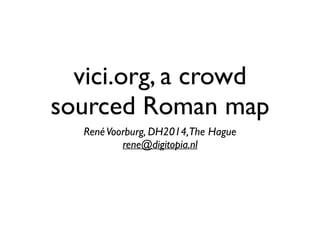Vici.org
- 1. vici.org, a crowd sourced Roman map RenÃĐVoorburg, DH2014,The Hague rene@digitopia.nl
- 2. Introduction
- 8. location aware HTML5 static JSON data
- 9. Design considerations âĒ When creating a database backend, why not opening it up for others to add / edit data? âĒ If others provide data, why not help them to retrieve and access the data? âĒ Wikipedia as a model, but maps central & multi-lingual âĒ Map embeddable by other websites âĒ Open JSON API, Pelagios RDF, downloads
- 10. Core functionality Users can add: âĒ Markers (since February 2012) âĒ Images (since May 2013) âĒ KML line tracings (March 2014) .. but no real community supporting features as of yet.
- 13. User engagement
- 18. User engagement summarized âĒ 200 activated user accounts âĒ 68 users added markers âĒ 6073 markers added by users âĒ 90% of all markers were added by 9 users. ! (June 2014)
- 27. Discussion âĒ How to attract users beyond NL, DE and BE? âĒ What did the 132 users that only registered expect? âĒ Populating the map âenoughâ appears to have been essential in engaging users âĒ Will an investment in community features pay off? âĒ Stuck in the middle between science and marketing?



























